Milestone 2
Introduction
For Milestone 1, PAWLs created three initial concepts that tried to help reduce any potential stress and anxiety that could be occurring in a dog’s new environment while transitioning into a new home. We determined that our target audience would be dog owners with adopted dogs who experience behavioral issues in the home. These three concepts included “Guardian”, a smart kennel, “Halo Collar”, a smart dog collar, and “Dog House”, a smart house, which were designed to recognize and reduce any potential stress and anxiety that could be occurring in a dog’s environment.
Study Design
Our study was designed so we could help answer the following key research questions that will help us further re-define our concepts to address the actual problems many dog owners face:
1. What kind of behavioral issues do dog owners typically deal with?
2. What typically triggers a behavioral issue with their dog?
3. Have dog owners done any training or coaching with their dog?
4. How do dog owners address behavioral issues as they occur?
5. Where do dogs normally feel safe??
To answer these two research questions and better understand the context surrounding how dog owners address behavioral issues with their adopted dogs, our study was conducted in two parts - a survey and a diary study.
1. Survey
For our survey, we tried to get an idea of how we can further define our scope and concepts by focusing on what specific behavioral issues dog owners are dealing with, and how common they occur. The survey was distributed through various channels, including various UMSI e-mail groups, along with Reddit and Facebook groups related to dog ownership and training. Most of the survey comprised of questions related to dog owner’s experiences with their dog, what kind of behavioral issues have occurred, if they’ve gotten dog coaching or training, and what owners do to help mitigate the dog’s behavior. We also asked users what kind of activities tend to trigger behavioral issues with their dog.
2. Diary Study
For our diary study, our goal was to understand how dog owners addressed behavioral issues right as they’re occurring, along with their frequency. Participants were recruited through our survey responses of owners who specifically adopted their dogs. For five days, 2 participants recorded dozens of entries in a behavioral log every time a dog experienced any emotional distress. One of the major limitations of our diary study was the lack of reliable participants - initially, 4 participants agreed to complete a diary study, but only 2 participants responded when the diary study needed to be returned.
The first part of the diary study allowed us to better understand each dog’s unique history and temperament. We asked their owners to give us general information about their adopted dog, including name, age, breed, past training, favorite treats and toys, and where the dog normally feels safest.
In the second part of the diary study, participants were tasked with keeping a behavioral log of every instance of their dog experiencing any distress, when and where it occurred, what triggered the dog’s response, how serious the dog’s response was, and what the owner’s did about the dog’s distress. These behavioral logs helped us better understand how dog owners react to their dog’s emotional distress and whether or not one of our three concepts might provide a better solution.
Study Results
1. Diary Study
The diary study was analyzed by breaking down every component of the behavioral log, including each specific trigger, location, the dog’s response, and how the owner responded to the dog’s inappropriate behavior. We used Trello to create an affinity board to help organize common themes between the participants and their dogs. Participants recorded a wide range of behavioral issues related to their dogs, including instances of their dogs begging for food, responding to abrupt noises, responding to other people, and responding to other dogs.
1. Triggers :
“Noise in the building”
“Someone walking next to us”
“Door clicking in hallway”
"Other dogs”/“Leashed Dogs”
“There was a kit-kat in my tote bag, FULLY WRAPPED”
“Squirrel”
“Dog hopped on the sofa next to me and got within an inch of my plate to sniff it”
“Dog barking “under his breath” on the sofa, this lasts for a while and is almost reflexive like a hiccup”
“Ran towards squirrel, tense posture"
“Dog barking at door for full minute”
“Dog trying to go up to someone, person comes up to dog, dog goes on hind legs growls/nips at person, gets a slight scratch on person!!!”
“Barking, whining, pulling towards (other) dog, wagging tail”
“Positive voice asking him to come to me, telling him no”
“Held tight to my dog’s leash, called out to him in positive voice to catch his attention (which didn’t really work), pulled him in the opposite direction”
“Positive voice asking him to come to me, telling him no, then since it’s after 10:00pm, called him into the kitchen with me, asked him to sit, gave him a treat, which did make him stop”
“Click and treat protocol”
“Utilized reinforcement protocol outlined by our trainer- click when she looks at the dog and provide a treat (cheese)”
“Stella loves cheese. She isn’t big on toys, but when she plays with them, she prefers plush toys.”
“Snuggled on the couch in our family room.”
“Milk Bone Soft & Chew Filet Mignon flavor. Large white lamb toy”
“When I am home – he either likes my lap or his crate. When I am not home, he goes on the ottoman I keep next to my bed.”
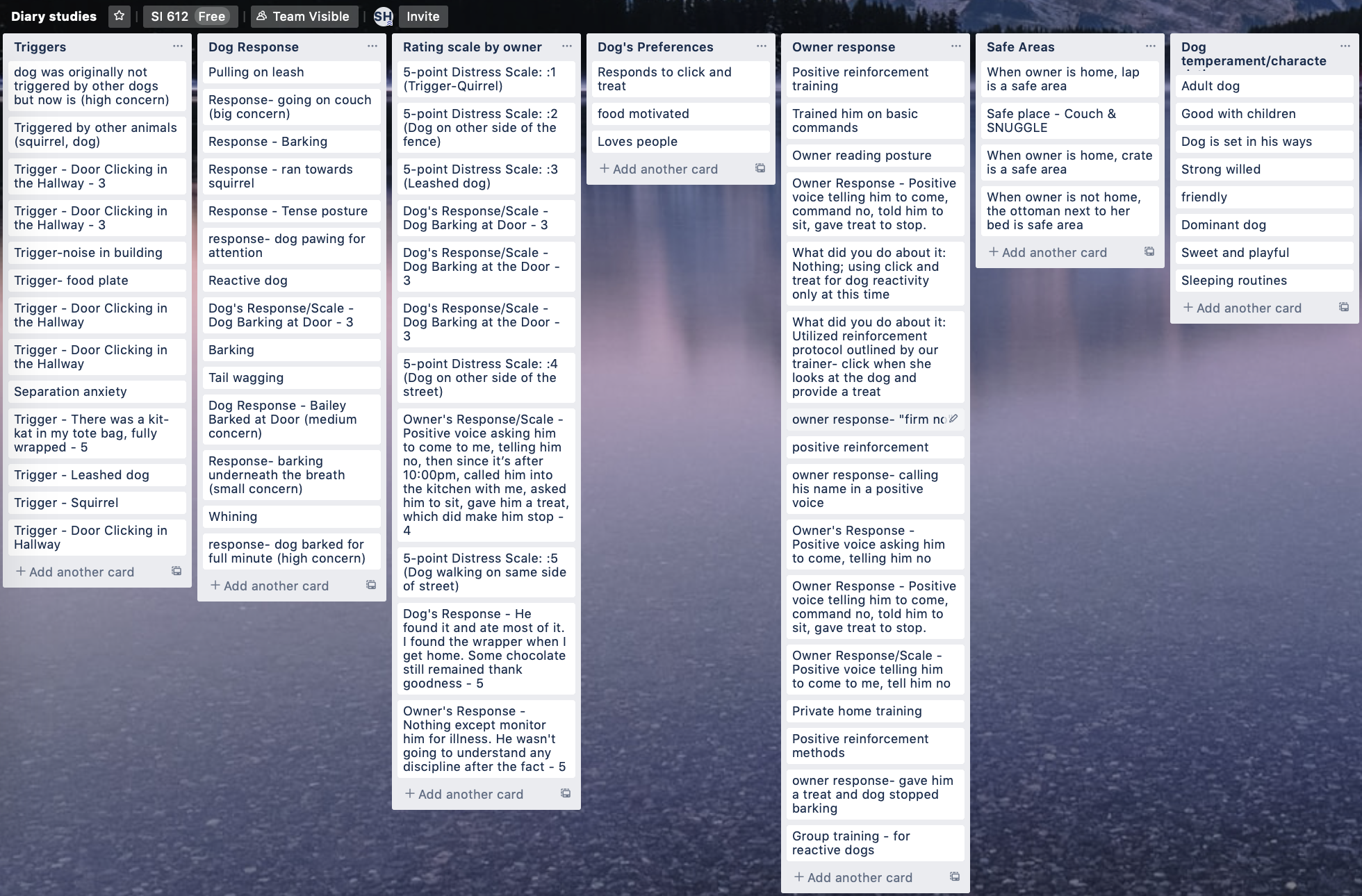
Affinity wall brainstroming on diary studies
2. Survey
Of the 466 total respondents to our survey, 142 fit within our target audience and reported that they both adopted their companion and experienced behavioral issues after doing so. The following are a few key assumptions that the survey validated or negated, helping us further narrow our scope and establish new ideas for our three concepts.
The first finding that supported our earlier assumptions was that barking, whining, and other maladaptive noise-related behavior were among the most common issues experienced by newly adoptive pet owners. Respondents also helped us expand out ideas by suggesting other behaviors, such as fearfulness and aggression, to consider. The second assumption that was confirmed by our survey results was that the majority of behavioral issues occur shortly after adoption, primarily in the first month.
One of our primary research objectives was to determine what triggers were associated with the behavioral issues experienced by newly adopted dog owners. Our data collected from these responses on the survey were both helpful and raised important questions for us moving forward. One of the available responses to a question asking owners to identify what the triggers were for their dogs was “Leaving the house”. After the survey had been deployed, we realized the meaning of this response may be unclear, as it was not specified whether it was the owner leaving the house or the dog leaving the house. As such, we intend to explore this topic moving forward with interviewees. Additionally, the majority of respondents in our target audience cited interpersonal issues as being one of the most common experienced in the first month after adoption. These included interactions with other people and dogs, and together accounted for 100+ responses to this question.
Finally, and perhaps most importantly, we were able to get great insight into the ways owners approach training their dogs. Prior to deploying the survey, we held the assumption that most trainers do not seek any kind of professional help when training their dogs. Of our survey respondents in our target audience, nearly 80% sought help from some kind of professional, including behaviorists, trainers, veterinarians, or adoption specialists. Through this, we learned that respondents value and will dedicate resources (time, money, etc) toward professional-level help. Finally, this and related questions helped us determine what was valuable to owners in terms of training and behavior modification techniques. In particular, owners were committed to positive reinforcement-based techniques.
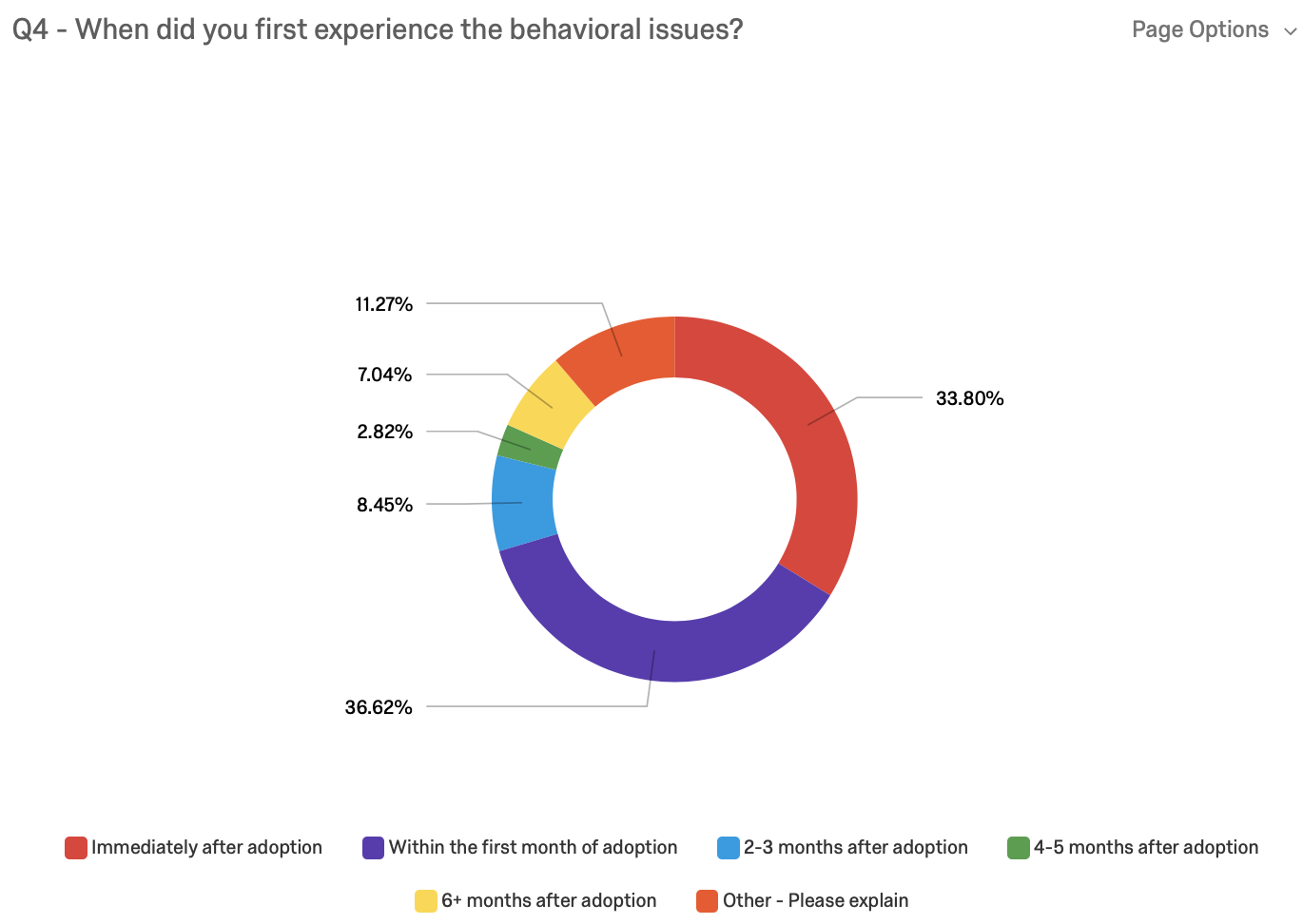
When did you first experience the behavioral issues?

What behavioral issure have you observed?
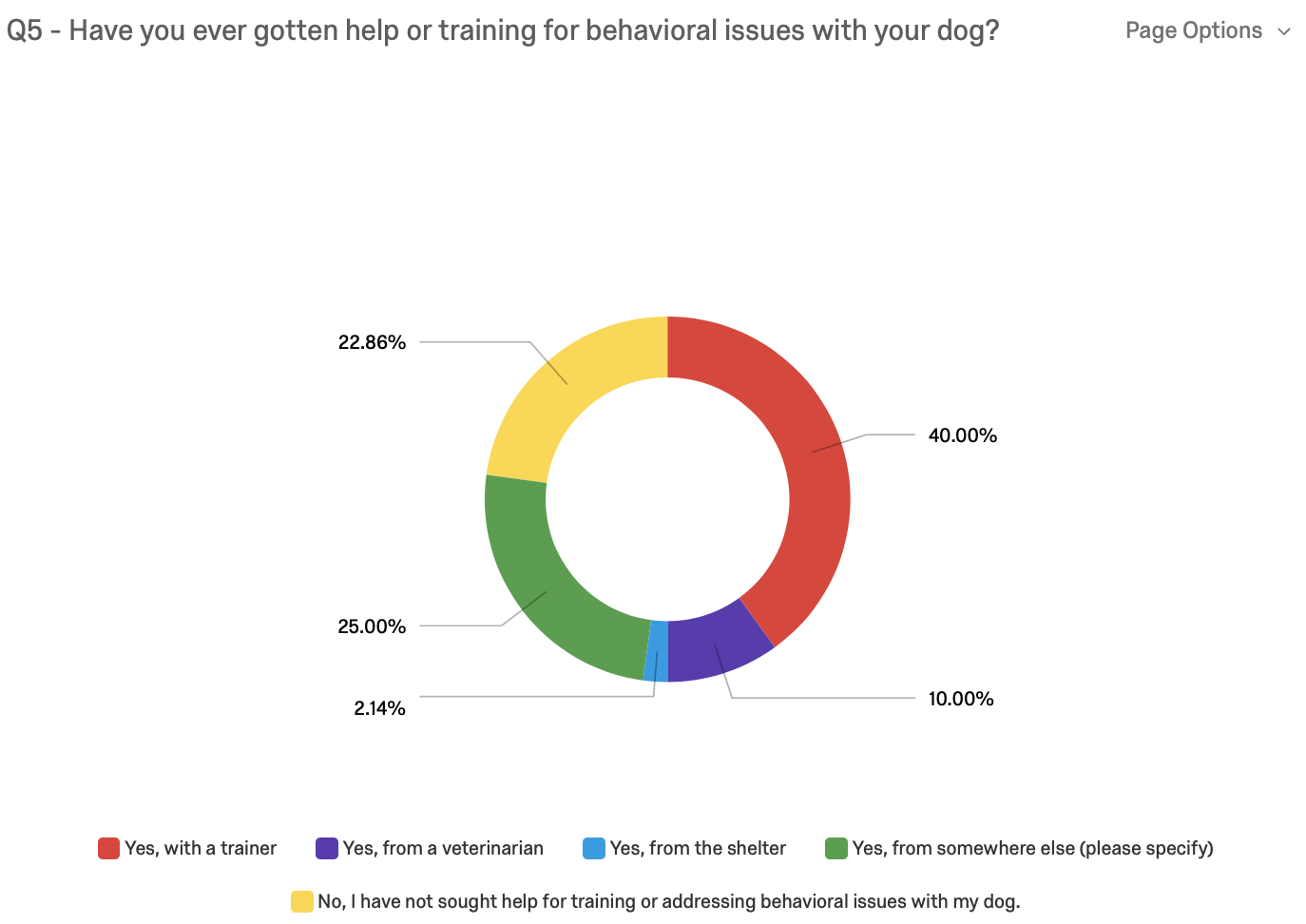
Have you ever gotten help or training for the behavioral issues with your dog?
Ideation and Selection
Our ideation was mostly focused on the insights we got from our affinity map of diary study, and the qualitative data analysis we obtained from our survey. The themes we generated helped us in our further ideation. We noticed that behaviors like barking and responses like positive reinforcement worked for most of the owners. We also wanted to tackle the problem of noise reaction. Here are some ideation examples :
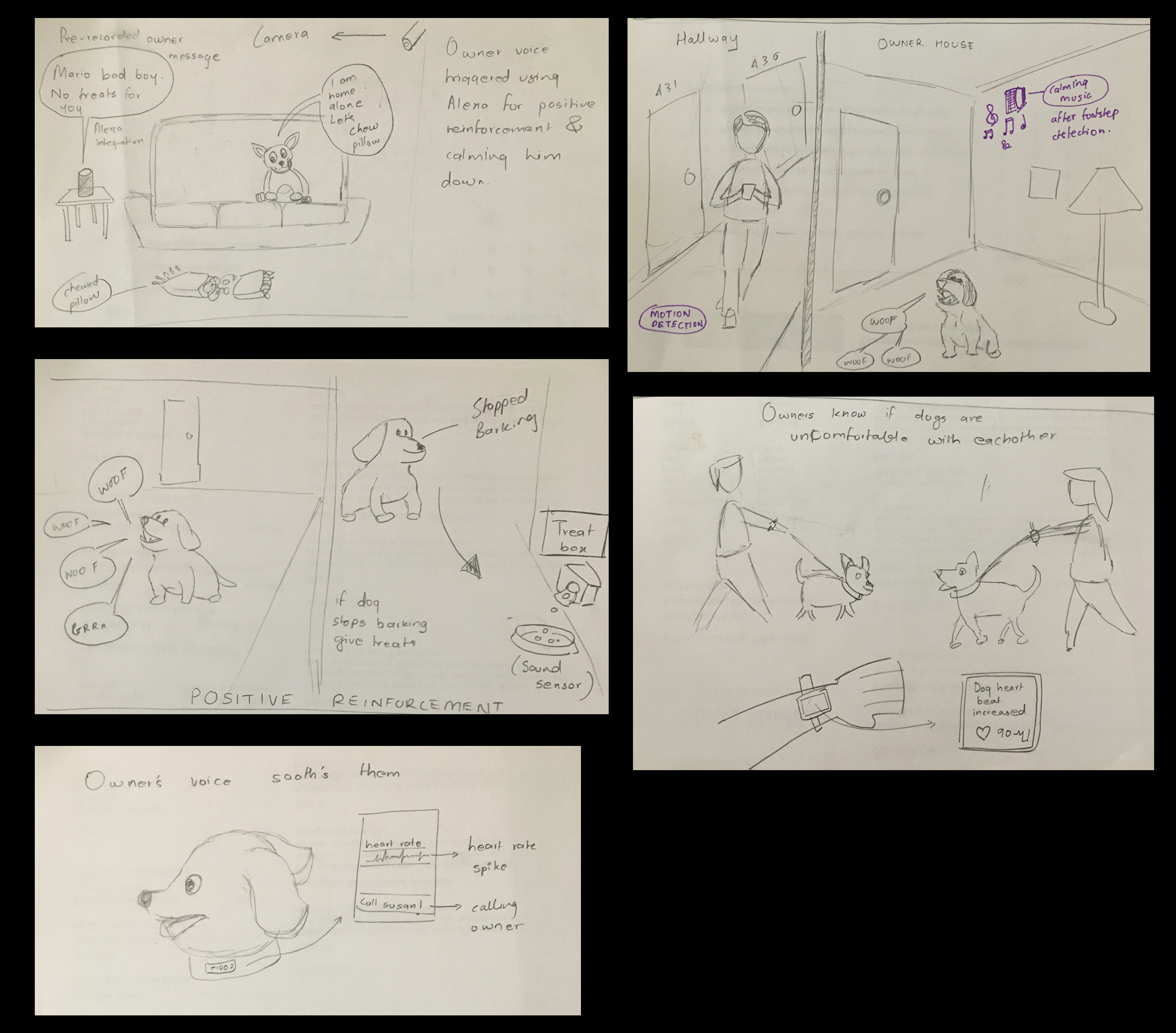
Ideation images
Criteria of Selection
1. Dog oriented : The technology should be oriented towards solving the dog’s problems.
2. Positive Reinforcing : The underlying working should provide positive reinforcement to the dog. Our diary study revealed that owners try to train their dogs using positive reinforcement. Positive reinforcements like click and treat work for them.
3. Effective : The system should be robust enough to work in every scenario. The dog might react to various situations differently. The system should be able to work through every scenario.
4. Trigger nullifying : It should be able to understand when a dog is in need before the dog’s reaction. Some of the scenarios like dogs barking when someone walks in the hallway can be nullified using technology before it even happens.
5. Alter behavioral changes : The aim of the technology should be to slowly alter behavioral changes in the dog. With this solution we aim to build in a change in the dog’s behavior throughout the usage. Example: Like the positive reinforcement would get better using more treats.
6. Well-being : T The technology should not discomfort the dog. The solution needs to encompass their needs.
Refined Scope and Concept
Originally, we wanted to target all newly adopted dog owners within their first month after adoption with dogs exhibiting behavioral issues. From the diary studies, we learned that the most frustrating dog behaviors were aggression triggered by the presence of other animals and indoor barking triggered by an auditory stimulus. To narrow our scope, we elected to just focus on discouraging dogs’ disruptive indoor barking rather than try to target both behavioral issues since aggression involved more variables such as another animal. Using positive reinforcement and stimulus masking methods, we hope that our solution will train the dog when the owner is not home to provide the training themselves. Additionally, we hope that owners, by seeing the Guardian in use, will develop a deeper understanding of what triggers and calms their dog’s barking. Our refined target audience includes newly adopted dog owners who spend more than an hour, on average, away per day from their barking-prone dogs.
Concept 1: The Guardian
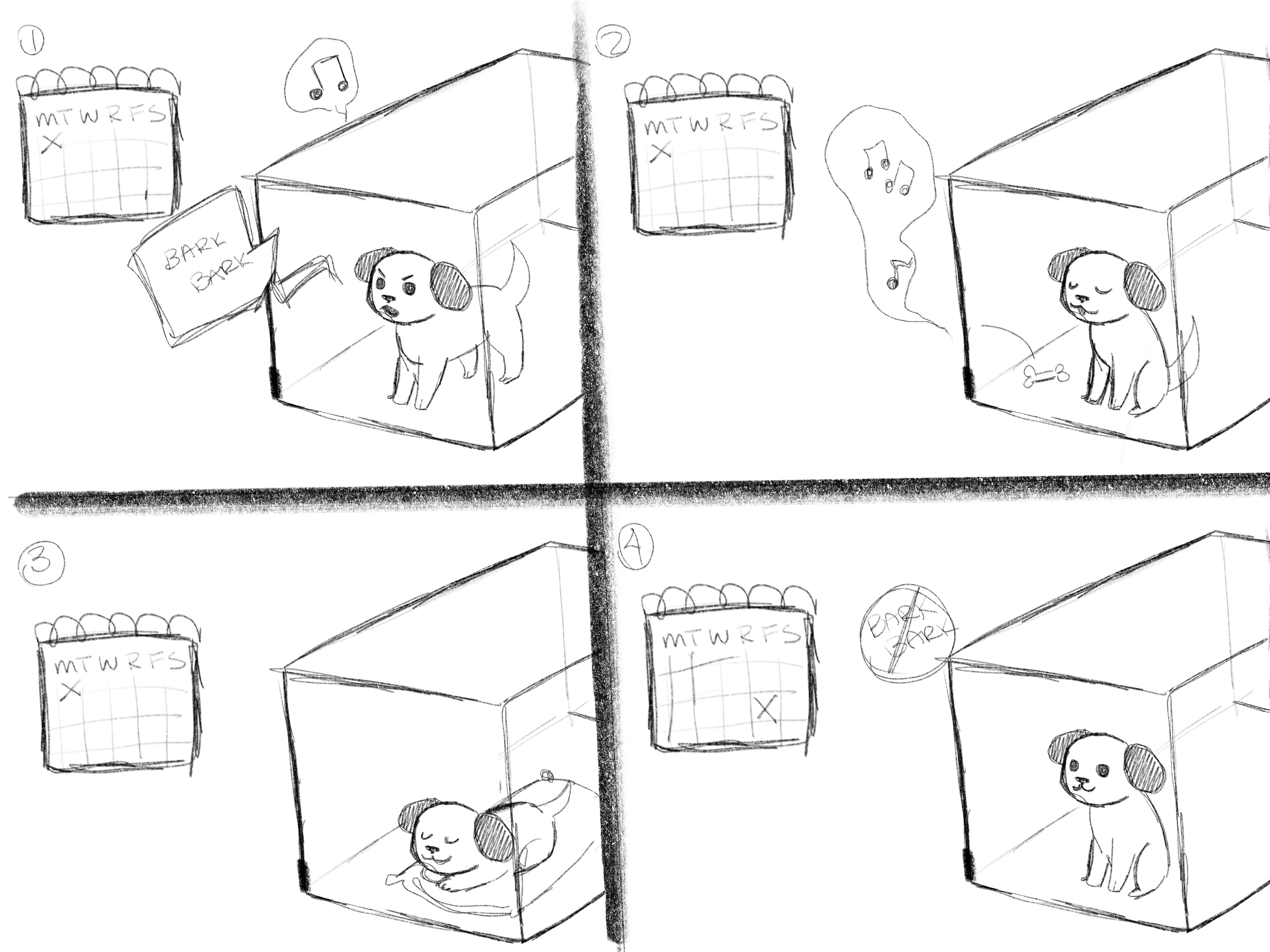
The Guardian
1. Fido begins barking violently while his owner is at work.
2. The Guardian begins to play calming music to mask the auditory stimulus.
3. The Guardian comes with a bed that can warm up or cool down if it senses abnormal temperature.
4. After 2 weeks, the dog does not bark violently.
The Guardian meets the following criteria in these ways:
1. Dog Oriented : The Guardian takes the form of a crate which is regularly and commonly used in dog training. 2. Involves Positive Reinforcement: The Guardian rewards the dog’s good behavior. When the dog stops barking for a certain amount of time, a treat will be automatically distributed by the Guardian. 3. Effective: The Guardian is able to manage a dog’s barking in various ways. When the dog barks, the Guardian will play a pre-recorded audio of the owner giving the dog commands. Additionally, pheromones will be released to calm the dog. 4. Trigger Nullifying: The Guardian can sense outside noise and play calming music to mask the auditory stimulus and to accommodate for instances when the stimulus is visual, the dog’s view will also be blocked off by automatically drawn curtains. 5. Behavior Changing: As the dog’s barking frequency decreases, over a period of time the Guardian responses such as calming music playing and dropping curtains will also “weaken.” For example, music will be played quieter to not completely mask the auditory stimulus, and the curtains will not completely block off view. 6. Well-being: The comfort of the dog is our highest priority. The Guardian includes a dog bed which will warm up or cool down if it senses an abnormal body temperature.
Concept 2: Halo Collar
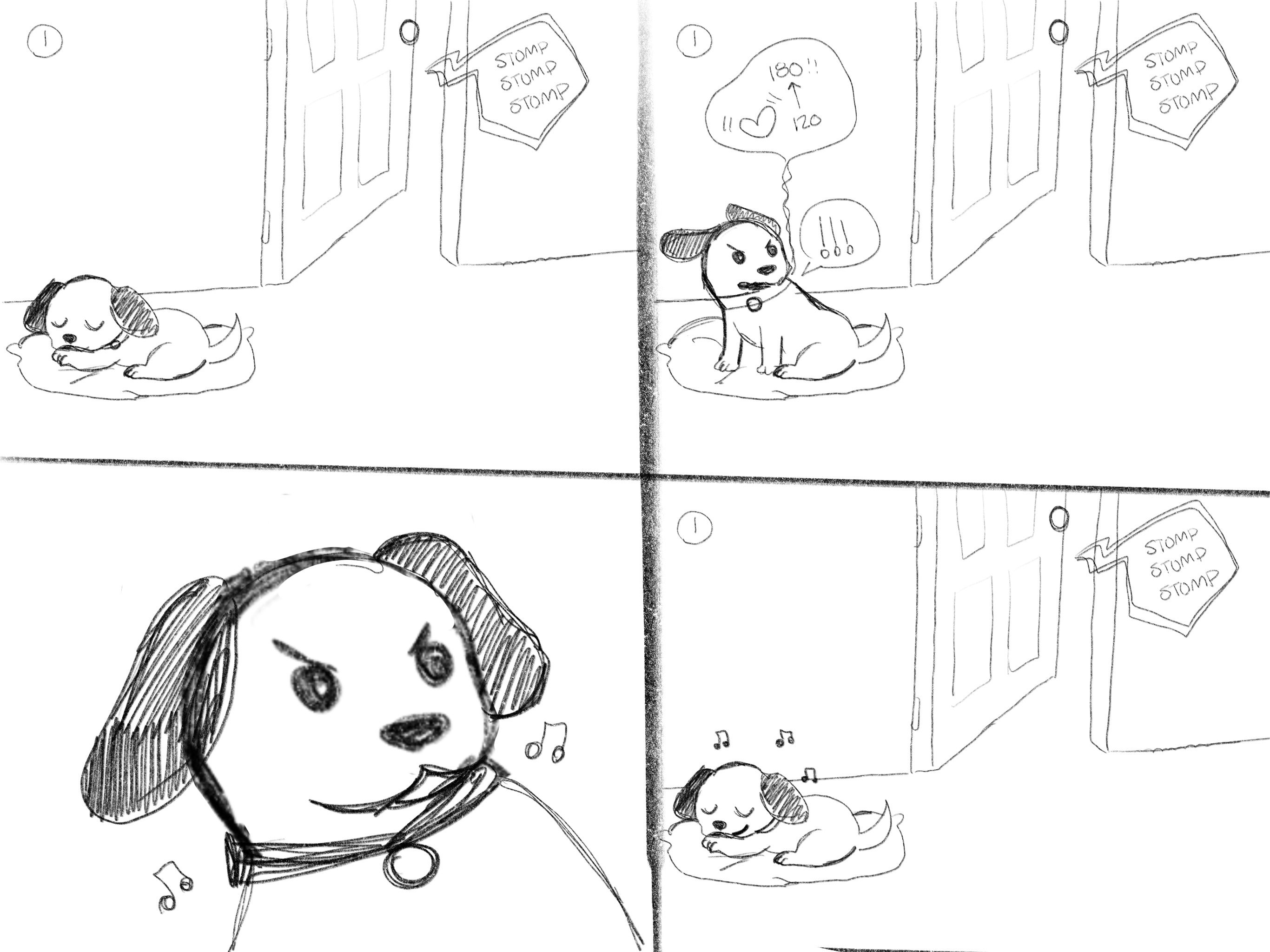
Halo collar
1. Dog is calmly sleeping when someone is stomping by the door.
2. The dog is startled and woken up by the stomping. The dog’s heart rate increases 40bpm.
3. TThe Halo Collar plays music to mask the auditory stimulus.
4. The dog falls asleep as the music is masking the stomps outside.
The Halo Collar meets the following criteria in these ways:
1. Dog Oriented : The Halo Collar takes the form of a collar, which is an object that dogs use commonly. 2. Involves Positive Reinforcement: Involves Positive Reinforcement: The Halo Collar positively reinforce the dog’s good behavior by playing the pre-recorded dog owner’s voice of praising the dog. 3. Effective: TThe Halo Collar does not meet this criteria. The collar senses the dogs’ heart rate as a potential indicator to the dog’s disruptive behavior however a happy dog can also have an increased heart rate. 4. Trigger Nullifying: The Halo Collar can sense outside noise and play calming music to mask the auditory stimulus. 5. Behavior Change: The Halo Collar does not meet this criteria. Most of Halo Collar’s responses influence the owner’s behavior rather than the dog’s behavior. 6. Well-being: he Halo Collar tracks the dogs location to identify potentially disruptive routes that can trigger stress in dogs. Halo Collar encourages owner involvement so that the burden on the dog can be decreased. The owner can learn to avoid these routes.
Concept 3: The Dog House
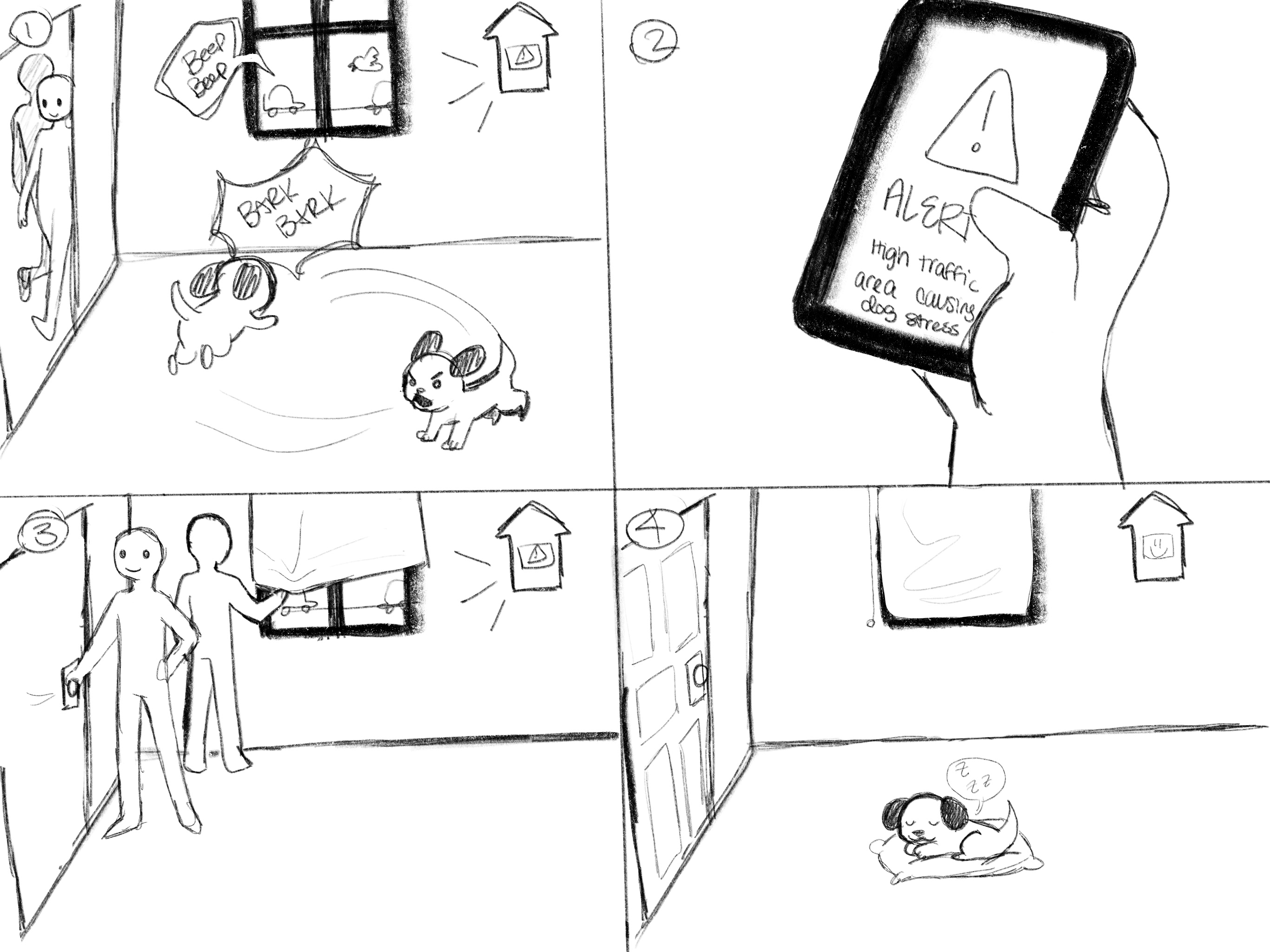
The Dog House
1.There are cars outside that triggered barking in dogs and the Dog House is able to detect the trigger.
2. The Dog House relays the message to the owner that there is high traffic causing the dog stress.
3. The owner comes in to close the blinds and door to decrease triggering stimulus.
4. The dog is able to calmly fall asleep after the triggers are removed.
The Dog House meets the following criteria in these ways:
1. Dog Oriented : The Dog House is a system meant to augment the house for dogs that are not kept in crates when the owner is not home. 2. Involves Positive Reinforcement: The Guardian rewards the dog’s good behavior. When the dog stops barking for a certain amount of time, a treat will be automatically distributed by the Guardian. 3. Effective: The Dog House is able to locate potential triggers before behavioral issues can arise. The Dog House identifies potential issues for the owners during the process of “puppy proofing” using motion, light, and sound sensors and notifies the user through phone notifications and the central communication screen located near the home’s thermostat(s). 4. Trigger Nullifying: Dog House would allow the user to open and close doors and blinds, shut off lights, and decrease the sensory load on anxious, fearful, or aggressive dogs from their phone or compatible device. 5. Behavior Change: As the dog’s barking frequency decreases, over a period of time the Dog House responses such as calming white noise playing and closing of blinds will also “weaken.” For example, the noise will be played quieter to not completely mask the auditory stimulus, lights will be dimmed not shut off, and the blinds will not completely block off view. 6. Well-being: The comfort of the dog is our highest priority. The Dog House does not confine the dog to a small space and rather allows the dog the freedom to roam throughout the house.
Conclusion
To narrow our scope, we decided to focus on discouraging dogs’ disruptive indoor barking triggered by auditory and visual stimulus. Using positive reinforcement and stimulus masking methods, we hope that our solution will train the dog when the owner is not home to provide the training themselves. Our refined target audience is newly adopted dog owners who spend more than on average, an hour away per day from their barking-prone dogs. Moving forward, we want to focus on influencing the dogs’ behaviors which is ultimately for the dog owners, so our user group still consists of dog owners.